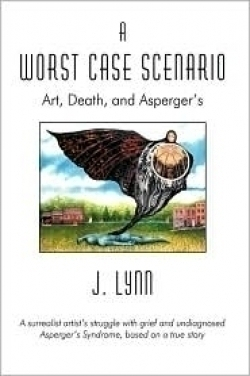A Worst Case Scenario
Art, Death, and Asperger's
Today’s educational system attempts to insure that children who need extra help don’t “fall through the cracks.” In the past, students with mild developmental disorders went through public school with little attention paid to their special needs. Those blessed with understanding teachers and supportive families thrived, but others kept failing until they gave up on school entirely.
Writing under the pseudonym of J. Lynn, the author did well in school, showing an early aptitude for art, but was always aware of being “different.” In A Worst Case Scenario, an only child of older parents writes about her family history, early childhood memories, the steadfast parental devotion she received, and her passion for art. The deaths of her mother, best friend, and father within a year’s span, cause her extreme emotional distress. These losses cause Lynn to stop painting, isolate herself from friends, and question her place in the Fells Point neighborhood of Baltimore. After relocating, she finally identifies, with the help of a new friend, the “Thing” that has persistently set her apart from the norm.
The author spent her childhood and early adult years in Severn, Maryland, eventually earning a bachelor’s degree in visual and performing arts from the University of Maryland.
Just before her mother dies, an audiologist prescribes hearing aids to correct Lynn’s hereditary hearing loss. She realizes that being hearing impaired compounds her problem understanding the nuances of conversation. Lynn writes, “I would buy the hearing aids after Dad died… I would need to pay strict attention to legal advice and other important things.”
During this period the author felt as if she were dead, a state of mind that led her into deep introspection. Realizing that her intense focus on art had caused her to neglect her parents and friends, she writes, “There have always been pieces missing of me. The irony, the sad irony is, there are just enough pieces present to know something is missing.”
This effort to probe her inner psyche moves her to take action. Although the tasks that must be done after her parents’ death overwhelm her, she perseveres. “It has been difficult to try to do everything, such as bills, clean, paperwork, houses,” she says. “I need the time alone. I get migraines.”
The value of an autobiography such as this cannot be underestimated. It describes the challenges of a person who excels in certain areas of her life but has trouble accomplishing the mundane responsibilities that others manage easily. The book lacks organization; subject digressions, repetitions, grammatical and typographical errors, plus use of passive voice and awkward syntax make the story difficult to read. The author might have considered fewer words and more art work, in addition to the two pieces of cover art, to tell this story more succinctly.
Those with the tenacity to persevere to the book’s conclusion will be rewarded with greater understanding of how someone copes with Asperger’s Syndrome in a society at odds with that unique way of being.
Reviewed by
Margaret Cullison
Disclosure: This article is not an endorsement, but a review. The publisher of this book provided free copies of the book and paid a small fee to have their book reviewed by a professional reviewer. Foreword Reviews and Clarion Reviews make no guarantee that the publisher will receive a positive review. Foreword Magazine, Inc. is disclosing this in accordance with the Federal Trade Commission’s 16 CFR, Part 255.

